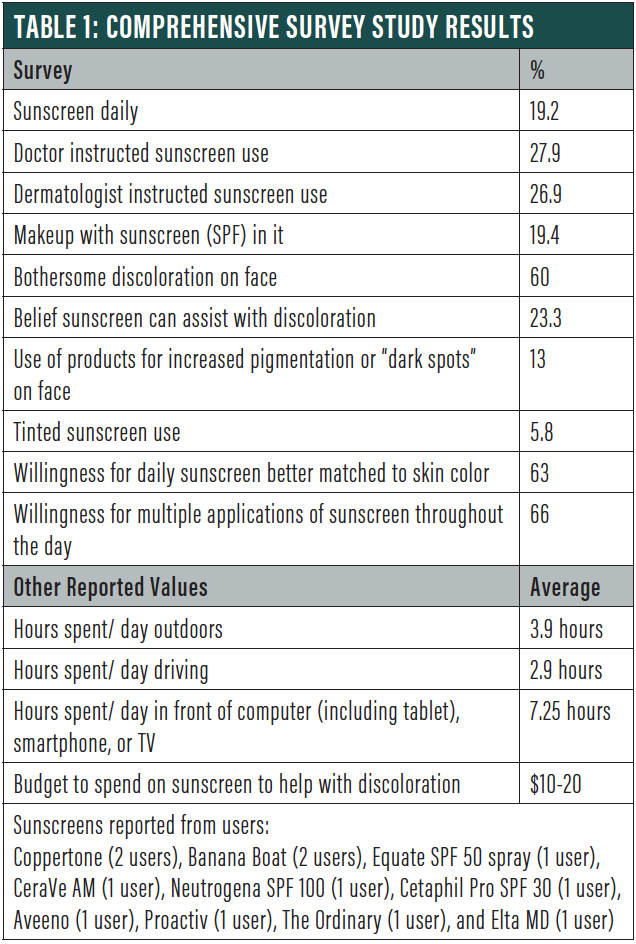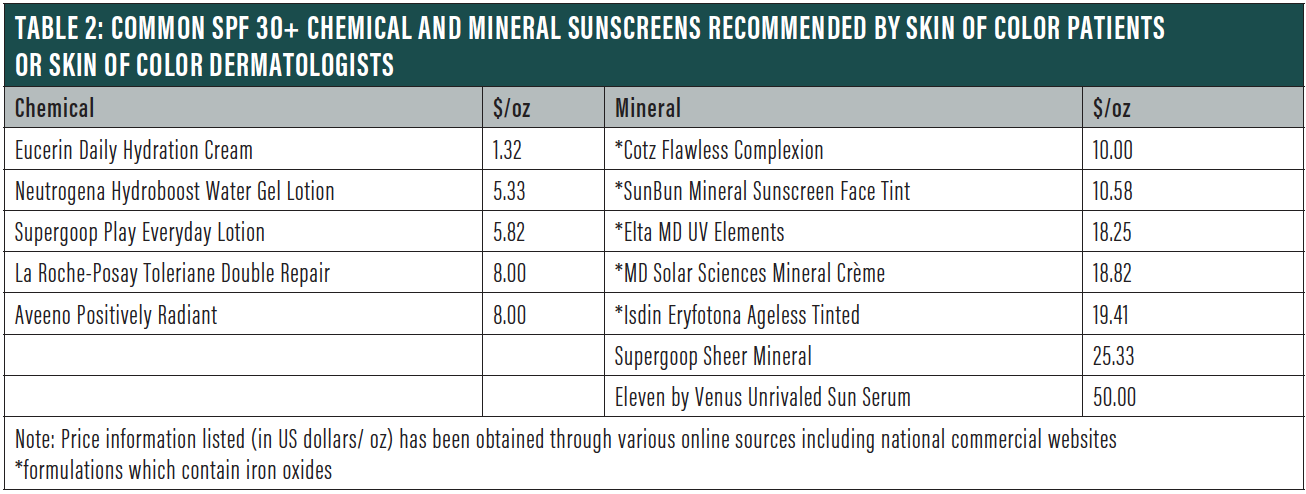Although previously thought to be harmless, visible light has been proven to have negative effects on the skin.1 The combination of both ultraviolet (UV) radiation and visible light can be particularly problematic for skin of color patients by inducing immediate pigment darkening and bothersome discoloration.2 While chemical sunscreens can protect against UV rays, mineral sunscreens containing zinc oxide and titanium dioxide provide additional protection against visible light and can help prevent discoloration in skin of color patients.3 Although these mineral sunscreens may help protect against dyschromia in Fitzpatrick IV-VI individuals, often a white cast is left on the skin due to opacity of these metal oxides.
The Bottom Line
About 20 percent of patients with skin of color use sunscreens daily, and rates of use are even lower among patients with concerns about skin discoloration. Patients can benefit from expanded counseling on sunscreen use and protection from UV and visible light. Iron oxides are incorporated into mineral sunscreen formulations to enhance skin protection while offering cosmetic acceptability.
To overcome this cosmetic hurdle, iron oxides are now incorporated into these sunscreens, allowing for a more elegant and compatible cosmetic application while still providing further visible light protection.4 In a time where we spend countless hours exposed to blue light sources, such as our smartphones, tablet screens, and ambient fluorescent light, it is imperative that patients with skin of color adopt the daily use of these tinted mineral sunscreens to prevent discoloration and post-inflammatory hyperpigmentation (PIH), which may be exacerbated by these visible light sources. We conducted a survey to investigate current beliefs among a sample of skin of color patients to assess their understanding of sunscreen’s role in preventing bothersome dyschromia.
Sunscreen Use Trends
A 15-question survey was given to a total of 103 Fitzpatrick IV-VI patients prior to their visit with a dermatologist at our LSU Baton Rouge MidCity Dermatology Clinic. The survey investigated patients’ daily sunscreen use, instructed sunscreen use from dermatologist, bothersome discoloration of the face, and perception of sunscreen’s role in preventing exacerbation of dyschromia. To assess risk factors, patients were also asked to report the amount of time spent outdoors or in front of various blue light sources.
Among this small sample of patients, only 19.2 percent reported daily sunscreen use—consistent with other studies showing infrequent use of at least one sun-protective behavior (sunscreen being the least prevalent).5 Only 27 percent of patients reported that another doctor or dermatologist had spoken to them about the importance of sunscreen. This suggests sunscreen underuse may be attributed to a potential lack of knowledge about its value and role. This is congruent with other findings that demonstrate that fewer screening and education programs have historically been targeted toward the skin of color patient population; only 2.3 percent of Black patients and 3.9 percent of Hispanic patients were provided or participated in skin cancer screenings during the first 30 years of the nationwide AAD screening and education programs.6 This highlights the opportunity for increased patient education and screening for this patient population.
Discoloration is a common problem for our skin of color patients with almost 60 percent reporting bothersome discoloration on their face. Only 11 percent of this subgroup of patients reported currently wearing sunscreen. When assessing sunscreen’s role in preventing dyschromia for these patients, only 23 percent believed sunscreen could help their discoloration. This suggests almost 80 percent of patients with hyperpigmentation in this sample could benefit from education about sunscreen’s role in treating their discoloration problems. Perhaps if more patients were aware of the role visible light and UV light have in the exacerbation of dyschromia, they would be more likely to use sunscreen for protection.

PROACTIVE STRATEGIES
With limited procedures available for correction of dyschromia in skin of color patients due to the risk of hyperpigmentation and scarring, dermatologists can proactively recommend mineral sunscreen therapy for preventing and treating hyperpigmentation in skin of color patients. For functional and cosmetic benefit, focus may be directed specifically to the iron-oxide containing tinted sunscreens to broaden protection against visible light-induced photodermatoses, a prevalent risk factor as demonstrated in our survey by a reported 7.25 hours of daily visible light exposure. While protective against visible light, these sunscreens are also more cosmetically compatible with skin of color skin tones. About 78 percent of surveyed patients with dyschromia said they would be willing to wear sunscreen every day if it was better matched to their skin tone, further emphasizing the historic challenge in finding practical sunscreens compatible with their skin tones.
In addition to this hurdle, many of the tinted mineral sunscreens can be more expensive than chemical sunscreens. Table 2 lists a selection of SPF30+ sunscreens both chemical and mineral that have been recommended by our skin of color patient population or by skin of color dermatologists on social media. Several of the more cosmetically elegant mineral sunscreens contain iron-oxide formulations and are unfortunately often more expensive. Dermatologists should consider price and compatibility with skin tone when recommending sunscreen to patients.

To provide the most optimal treatment for skin of color patients with or without dyschromia, dermatologists can provide directed counseling for at risk-patients by surveying patients prior to their appointment (Table 3). This allows the physician to provide efficient counseling while considering the patient’s current discoloration problems, views on treatment opportunities, and budget for hyperpigmentation treatment plans.

Screen and Counsel
It is evident that sun safety behavior and knowledge warrant increased attention in the skin of color patient population to address the low prevalence of sunscreen use among these patients. Mineral sunscreens (and tinted mineral sunscreens) should be continuously emphasized as an essential component for skin cancer prevention and treatment for hyperpigmentation. Dermatologists should be aware of patients’ low perception of the relationship between UV/VIS light exposure and dyschromia. It is important for physicians to efficiently screen and counsel patients at risk for dyschromia, photodamage, and skin cancer and provide them with resources to identify the most affordable and compatible mineral sunscreens.
The authors have no relevant financial or nonfinancial relationships to disclose.
1. Liebel F, Kaur S, Ruvolo E, Kollias N, Southall MD. Irradiation of skin with visible light induces reactive oxygen species and matrix-degrading enzymes. J Invest Dermatol. 2012;132(7):1901-1907. doi:10.1038/jid.2011.476
2. Kohli I, Chaowattanapanit S, Mohammad TF, et al. Synergistic effects of long-wavelength ultraviolet A1 and visible light on pigmentation and erythema. Br J Dermatol. 2018;178(5):1173-1180. doi:10.1111/bjd.15940
3. Lyons AB, Trullas C, Kohli I, Hamzavi IH, Lim HW. Photoprotection beyond ultraviolet radiation: A review of tinted sunscreens. J Am Acad Dermatol. 2021;84(5):1393-1397. doi:10.1016/j.jaad.2020.04.079
4. Dumbuya H, Grimes PE, Lynch S, et al. Impact of Iron-Oxide Containing Formulations Against Visible Light-Induced Skin Pigmentation in Skin of Color Individuals. J Drugs Dermatol. 2020;19(7):712-717. doi:10.36849/JDD.2020.5032
5. Pichon LC, Corral I, Landrine H, Mayer JA, Norman GJ. Sun-Protection Behaviors Among African Americans. Am J Prev Med. 2010;38(3):288-295. doi:10.1016/j.amepre.2009.10.041
6. Okhovat JP, Beaulieu D, Tsao H, et al. The first 30 years of the American Academy of Dermatology skin cancer screening program: 1985-2014. J Am Acad Dermatol. 2018;79(5):884-891.e3. doi:10.1016/j.jaad.2018.05.1242








